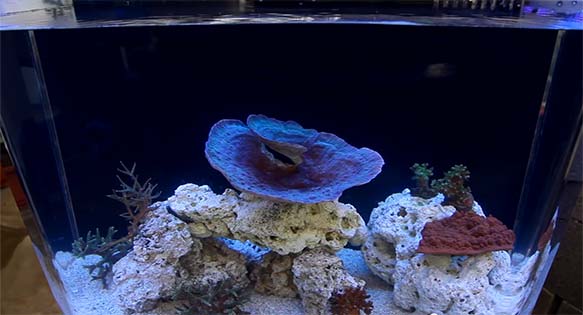We’d like to introduce and welcome the newest member of our CORAL Magazine online and print contributors, Than Thein, proprietor of Tidal Gardens, based in Ohio. We’ve long been impressed with his photography and videography, as well as his very welcoming demeanor. We hope you enjoy this first of many contributions from Thein. – The Reef To Rainforest Staff
I am perhaps the least likely person to have anything to say about nano reef aquariums. I am used to playing in massive water volumes at Tidal Gardens. In fact, our smallest system at the greenhouse is roughly 1,000 gallons, which makes any commentary on my part regarding nano reefs a little bizarre to say the least.
Having said that, I came across an old 25-gallon acrylic aquarium in desperate need of TLC and decided to restore it. The equipment and plumbing parts were placed in a vinegar bath to clean up any buildup of coralline. The tank itself was given a new finish using the 3-part Novus acrylic cleaning system. The video below shows a pretty dramatic difference in the tank before and after the acrylic polish.
Now that the nano reef tank is all polished up, the next step is to set up the equipment. The nice thing about this aquarium is that it has a partition separating the display side from the equipment side. Also, we can start aquascaping the display portion of the tank.
Ok, now that the tank is all filled, we can get to stocking. One of the issues nanoreefs face is a result of their size… the very thing that makes them an attractive option for tight spaces comes with it the disadvantage of instability compared to larger aquariums. Temperature or chemical changes can happen quickly so some fish and corals may not be well suited for a tank like this.
So what are some good choices? The video below takes a look at four possible stocking ideas. Nano reef aquariums have to be stocked more judiciously than larger aquariums. Their small size precludes fish that would outgrow its confines. In addition, corals have to be carefully selected to avoid species that either grow too quickly or become too aggressive in close quarters.
In summary, this nano has come a long way since the restoration and has a new lease on life. The bulk of the time was spent just removing the scratches. If you are willing to put in some elbow grease, used aquariums like this can be found all the time for cheap. People see the scratches and just give up on them. If this was your tank, what would you do with it?





